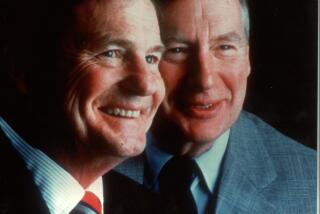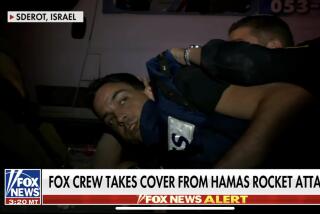Media Countdown Recalls Cuba Crisis
- Share via
Today’s TV coverage of the deadline countdown in the Persian Gulf most resembles coverage of the 1962 Cuban Missile Crisis, say a number of media analysts.
Reuven Frank, who has twice served as president of NBC News, once during the Vietnam War, said that “with (the Cuban Missile Crisis), people watched because they didn’t know what was going to happen. But nobody ever set a time limit. Kennedy gave the Russians an ultimatum, he set up a blockade, we got news that a Russian freighter had turned back, and that was kind of the end of the crisis.
“But the invasion (of Kuwait) was in August. And, finally, for whatever reason, they (United Nations) picked a deadline of midnight, Jan. 15. Nothing like this has ever happened in all of history--this much time pointing to a specific click of the clock. It’s going to be like New Year’s Eve, with everybody watching the ball fall.
“The use of the word countdown (by the networks) has been unfortunate. I don’t think any of the media have resisted contributing to the hysteria to build up that.”
While media watchers dubbed Vietnam the “living-room war” because, for the first time, America witnessed war on their TV screens, NBC News correspondent Garrick Utley felt that that war produced few single moments that captured TV viewers’ collective attention.
“Vietnam was a gradual process that you slipped into,” Utley said. “And this (Persian Gulf) was a buildup--we have seen the momentum building, we have known there has been a (deadline) for more than a month now, heard the statements of the leaders of both sides, and seen no change in their positions.”
Kathleen Hall Jamison, dean of the Annenberg School of Communication in Philadelphia, said that while the Cuban Missile Crisis may not have had the “countdown” quality that characterizes today’s watch, there still existed “the same feeling that the United States had done everything it could do, and was waiting for someone else to do something,” she said.
“The stakes are extremely high, and the outcome is uncertain. We have a sense that the United States has now played its hand, and we are waiting for someone to respond--it is a direct parallel, there’s a worldwide uncertainty.”
Todd Gitlin, professor of sociology at UC Berkeley, and author of “The Whole World Is Watching” and “The Sixties,” remembers watching Kennedy’s 1962 announcement on television. “If you ask people who watched, they probably remember Kennedy’s face; they probably remember shots of the blow-ups of the photos of the Russian missiles, they may remember shots of limousines arriving at the White House--but I doubt that they remember any words,” he said.
“I turned on CNN last night at 8, and I saw a picture of the limousines arriving at the White House, bearing the members of the White House inner circle. And one look at the face of Colin Powell told me what is going on. That actually flew me back into a flashback of the missile crisis.”
With Persian Gulf images carefully controlled by the Pentagon, Gitlin added that so far viewers have used TV for updates, much like radio has been used since World War II. “In Israel, people tune into the news religiously, on the hour, there is a sense that that country hangs on the news,” he said. “I would expect that happens here now, too.”
Author David Halberstam chastised television for treating the deadline as “entertainment” by creating the countdown. “We know that, in the age of entertainment, it has to be a star story--and that’s because of the anchors,” he said.
Lawrence Lichty, director of media studies for the Woodrow Wilson International Center for Scholars at the Smithsonian Institution, said that since the Cuban Missile Crisis, political assassinations, not war events, have most likely focused the national attention on TV. “We had a similar sort of situation when Reagan was shot, and everyone was waiting to hear (how he was),” Lichty said. “Obviously, this is much more intense.”
The Annenberg’s Jamison said that more recently sporting events such as the Super Bowl have been the only events to fascinate most of the TV audience.
The analysts say the most important difference between 1962 and now is the sheer volume of media coverage, with cable’s CNN and C-SPAN’s providing continuous coverage. “Television is absolutely more powerful, and much more pervasive,” said Kathryn Montgomery, a former UCLA associate professor and now a research fellow at the Woodrow Wilson Center. “It’s more international now.”
More to Read
Sign up for Essential California
The most important California stories and recommendations in your inbox every morning.
You may occasionally receive promotional content from the Los Angeles Times.













